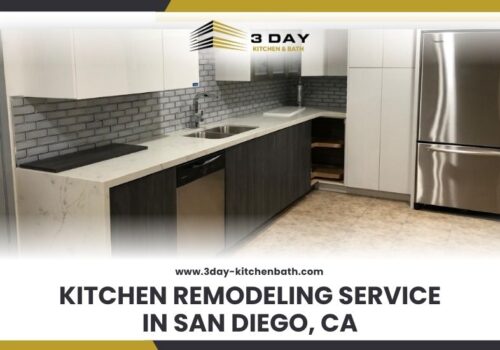Did you know that the average bathroom remodel can cost anywhere from $8,000 to $35,000? Understanding the major cost drivers can help you stay on budget while achieving the bathroom of your dreams. Knowing which parts of the remodel cost the most, you can focus on what's important and avoid overspending. In this post, we will explore the primary costs, such as plumbing, tile work, and vanities, to give you a clear bathroom remodel cost breakdown. Let's start by looking at how these expenses add up.
- What Drives the Cost of a Bathroom Remodel
- Average Costs for Bathroom Remodel in 2024
- Plumbing as the Most Expensive Part of a Remodel
- Why Plumbing Is Costly
- Ways to Save on Plumbing Work
- Tile Work and Its Impact on Remodel Budgets
- Comparing Tile Options for Every Budget
- Installation Labor Costs for Tile Work
- Cabinetry and Vanity Choices to Fit Your Budget
- Stock vs Custom Vanities: What to Consider
- Maximizing Storage While Minimizing Costs
- Flooring Options That Combine Durability and Affordability
- Popular Bathroom Flooring Materials and Their Costs
- Installation Costs and Considerations for Bathroom Flooring
- Lighting and Electrical Work in Bathroom Remodels
- How Lighting Affects the Overall Remodel Cost
- Upgrading Electrical Work in Older Homes
- Making Smart Choices for Your Bathroom Remodel
- Frequently Asked Questions
- How much does it cost to install a custom vanity?
- What are the pros and cons of using stock vanities?
- Is it worth investing in high-end flooring for a small bathroom?
- How can I reduce labor costs in a bathroom remodel?
- Are there ways to upgrade plumbing without moving fixtures?
- Plan Your Bathroom Remodel with 3 Day Kitchen & Bath

What Drives the Cost of a Bathroom Remodel
Several factors drive up the cost of remodeling a bathroom. Labor and materials are the two most important ones. For instance, changing plumbing fixtures, moving things around, or choosing high-end materials like marble will increase your budget. Labor costs depend on how many professionals you need to hire and the complexity of their work. Other cost drivers include:
- Size of the bathroom: Bigger bathrooms cost more to remodel.
- Quality of materials: Higher-end materials, such as luxury tiles or custom vanities, are more expensive.
- Layout changes: Moving plumbing and electrical systems adds to the cost.
Average Costs for Bathroom Remodel in 2024
The average cost of a bathroom remodel depends on the size of your bathroom and the choices you make regarding materials and fixtures. According to estimates for 2024, a small bathroom remodel can cost between $8,000 to $15,000, while larger, more complex remodels may range from $26,000 to $35,000. Here's a quick breakdown of bathroom remodel costs:
- Basic remodel: $8,000 to $15,000 (using stock fixtures and materials).
- Mid-range remodel: $18,000 to $24,000 (with some high-end finishes).
- High-end remodel: $26,000 to $35,000 (including custom features and layout changes).
Being aware of these average costs will help you budget better and focus on areas where you can save.
Plumbing as the Most Expensive Part of a Remodel
Plumbing is often the most expensive part of a bathroom remodel. Moving plumbing fixtures like sinks, toilets, or showers requires skilled labor, which increases the overall cost. While moving plumbing can add $2,500 to $3,500 per fixture, keeping existing plumbing in place could save you up to 30% of your total remodel budget. Understanding why plumbing is so expensive and how you can manage these costs is key to staying within budget.
Why Plumbing Is Costly
Plumbing is costly because it requires skilled work to prevent future problems. Moving or replacing plumbing fixtures often requires licensed professionals who understand how to connect new lines to the home's existing system. Here are some reasons why plumbing work can be expensive:
- Labor requirements: Only licensed plumbers can legally perform most of the work, and their hourly rates can be high.
- Moving fixtures: If you move a toilet, sink, or shower to a new location, you must reroute the water supply and drainage pipes, adding to the cost.
- Upgrading pipes: In older homes, outdated or damaged pipes may need to be replaced to meet modern plumbing standards. This upgrade can prevent leaks but comes with a higher price tag.
For many homeowners, the cost of moving plumbing fixtures can range from $2,500 to $3,500 per fixture, depending on the job's complexity.
Ways to Save on Plumbing Work
Although plumbing is one of the most expensive parts of a bathroom remodel, there are ways to keep the costs down without sacrificing quality. When selecting tile, opting for ceramic instead of natural stone can save you between $5 and $20 per square foot, without sacrificing durability or water resistance. Here are a few strategies to help you save:
- Keep existing plumbing in place: Instead of moving fixtures, consider keeping them where they are to avoid the extra costs of rerouting pipes.
- Upgrade strategically: Focus on essential upgrades like fixing old pipes or adding water-efficient fixtures. Avoid unnecessary plumbing changes that don't improve functionality.
- Get multiple quotes: Always get quotes from different licensed plumbers to compare rates and find a professional who fits your budget.
By making smart decisions about your plumbing, you can reduce costs and avoid unnecessary expenses.
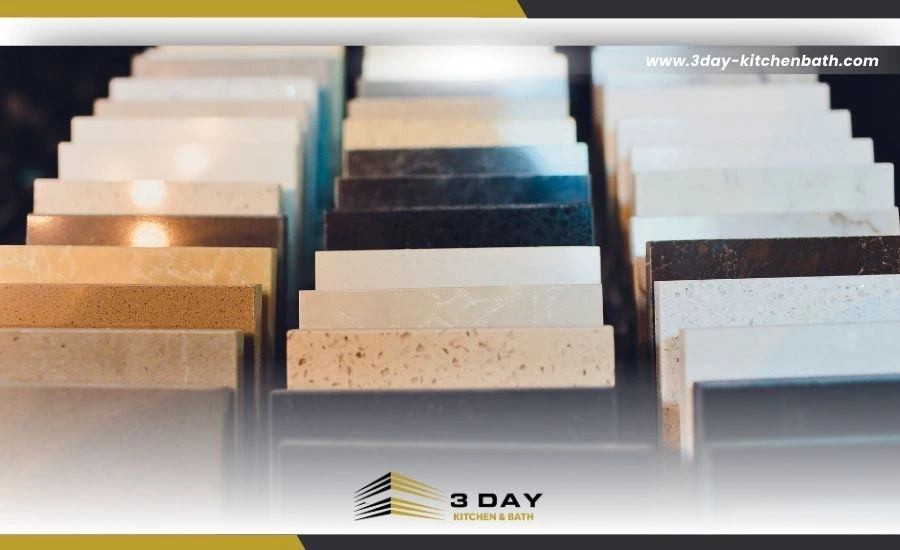
Tile Work and Its Impact on Remodel Budgets
Tile work plays a major role in the overall cost of a bathroom remodel. The materials you choose and the labor involved in installing tiles can significantly increase your expenses. Selecting the right tile and understanding the labor costs can help you control your budget without sacrificing style or durability.
Comparing Tile Options for Every Budget
Tiles come in many varieties, and the choice of material affects both the look of your bathroom and the final cost of the remodel. Whether you want something affordable or are ready to invest in high-end materials, there are options for every budget. Here are some common tile materials and their cost ranges:
Vinyl: This is one of the most budget-friendly options, costing around $1 to $2 per square foot. It is water-resistant and comes in a variety of colors and patterns.
- Ceramic: Ceramic tiles are slightly more expensive, around $2 to $7 per square foot. They are durable and offer many design possibilities.
- Porcelain: Known for being both beautiful and strong, porcelain tiles can cost $3 to $10 per square foot. They are often used to mimic the look of stone or wood.
- Natural stone: If you're looking for a high-end option, natural stone tiles like marble or granite can cost anywhere from $5 to $50 per square foot, depending on the quality and type of stone.
Choosing the right tile material is a balance between cost, appearance, and durability. It's important to pick a material that not only fits your budget but also suits the style and function of your bathroom.
Installation Labor Costs for Tile Work
The cost of tile installation includes both the price of materials and the labor required to set the tiles. Installing tiles is time-consuming and requires precision, which makes labor costs a significant portion of your bathroom remodel budget. Here's a breakdown of how tile labor costs can vary:
- Preparation work: Before laying the tiles, installers may need to prepare the surface, which can take several days, depending on the condition of the floor or walls.
- Tiling labor costs: The actual installation of the tiles typically costs $5 to $15 per square foot, depending on the complexity of the design and the type of tile being used.
- Time required: Large bathrooms with intricate tile patterns may take weeks to complete, increasing both labor time and overall cost.
To keep labor costs in check, consider using simpler tile patterns and opting for mid-range tiles that are easier to install. Limiting the amount of tiling to key areas like the shower or backsplash can also help reduce costs.
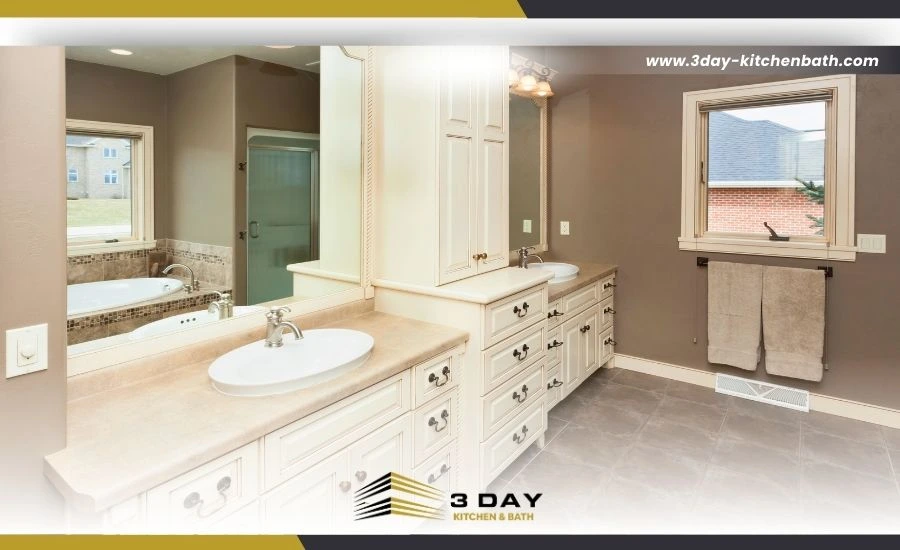
Cabinetry and Vanity Choices to Fit Your Budget
Choosing the right cabinetry and vanity is essential for both the functionality and aesthetics of your bathroom. While these items are important, they can quickly become expensive, especially if you go for custom-made options. By understanding the differences between stock and custom vanities, you can make informed decisions that fit your budget without sacrificing style or storage.
Stock vs Custom Vanities: What to Consider
When it comes to vanities, the choice between stock and custom options can make a significant difference in both cost and design. Here's what you need to consider:
- Stock vanities: These pre-made vanities are affordable and come in standard sizes and designs. Prices typically range from $700 to $900 for basic models. Stock vanities are ideal if you're on a tight budget and don't need highly customized features.
- Custom vanities: Custom-built vanities are made to order, allowing you to choose the exact size, material, and design. However, they come with a higher price tag, typically ranging from $1,900 to $4,800. Custom vanities are a good option if you want a unique look or have specific storage requirements.
The main trade-off between stock and custom vanities is price versus customization. Stock vanities are cost-effective and quick to install, while custom options allow for more personalized design but at a higher cost.
Maximizing Storage While Minimizing Costs
Whether you choose a stock or custom vanity, there are ways to maximize storage without overspending. Here are a few tips to help you get the most out of your vanity space while keeping costs down:
- Opt for a double-sink vanity: If space allows, a double-sink vanity not only enhances the bathroom's function but also adds more storage in the form of extra drawers and cabinets.
- Choose smart storage solutions: Look for vanities with built-in shelves, pull-out drawers, or compartments that can help keep your bathroom organized without the need for additional storage furniture.
- Use vertical space: Adding a medicine cabinet or wall-mounted shelves above the vanity can provide extra storage without taking up floor space.
- Consider ready-to-assemble (RTA) vanities: These vanities are more affordable and come with many storage options, giving you the flexibility to organize your bathroom on a budget.
Focusing on functionality and smart storage solutions can reduce the need for expensive custom options while still achieving the desired storage capacity.
Flooring Options That Combine Durability and Affordability
The flooring you choose for your bathroom can have a big impact on the space's durability and the overall cost of the remodel. Bathroom floors need to withstand water and moisture while also offering style. There are plenty of affordable and durable flooring options available, and choosing the right one can help you stay within budget.
Popular Bathroom Flooring Materials and Their Costs
When selecting bathroom flooring, it's important to consider both cost and durability. Here are some of the most popular materials and their price ranges:
- Vinyl: Vinyl flooring is one of the most budget-friendly options, costing between $1 and $2 per square foot. It is water-resistant, easy to install, and available in a variety of designs.
- Ceramic tile: A durable and affordable option, ceramic tile typically costs $2 to $7 per square foot. It's a great bathroom choice because it resists water and comes in many colors and patterns.
- Porcelain tile: Porcelain tile offers added durability compared to ceramic and is slightly more expensive, ranging from $3 to $10 per square foot. It's a popular choice for homeowners looking for long-lasting flooring.
- Natural stone: For a more luxurious option, natural stone tiles such as marble, granite, or slate can cost anywhere from $5 to $50 per square foot, depending on the quality. Stone is durable but may require more maintenance to keep it looking good over time.
Selecting the right material is key to balancing your budget and the long-term durability of your bathroom floor. Vinyl and ceramic tile are often the most cost-effective options, while natural stone can offer a more upscale look at a higher price.
Installation Costs and Considerations for Bathroom Flooring
In addition to the cost of materials, the installation process for bathroom flooring can add a significant amount to your remodel budget. Proper installation is important to prevent issues like water damage or uneven surfaces. Here are some factors that can affect flooring installation costs:
- Surface preparation: If your bathroom subfloor needs repairs or leveling, the installation process could be delayed and costed more.
- Tile layout complexity: Installing intricate tile patterns, such as herringbone or diagonal layouts, will increase labor costs due to the added time and precision required.
- Labor costs: Professional flooring installers typically charge between $3 and $10 per square foot for labor, depending on the complexity of the job and the material being installed.
To manage costs, consider choosing simple tile patterns and materials that are easier to install. Additionally, ensuring the subfloor is in good condition before the remodel can prevent costly repairs down the road.
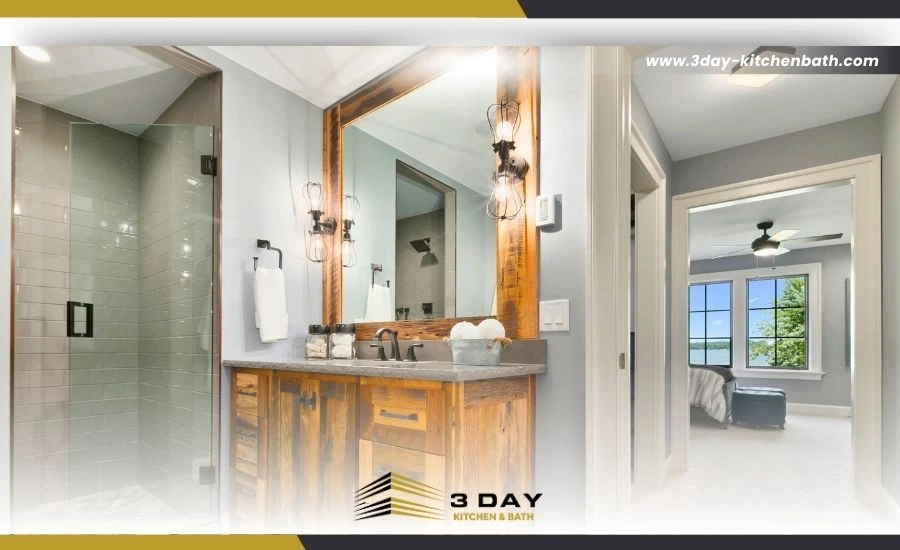
Lighting and Electrical Work in Bathroom Remodels
Lighting and electrical work play vital roles in a bathroom remodel, affecting the ambiance and impacting the overall cost. Proper lighting enhances the space's functionality, while electrical upgrades ensure that everything works safely and efficiently. However, depending on the fixtures and wiring changes required, these elements can add significantly to your budget.
How Lighting Affects the Overall Remodel Cost
Lighting is an important factor in any bathroom remodel, affecting aesthetics and practicality. The cost of lighting can vary greatly depending on the types of fixtures you choose and their installation requirements. Here's how lighting can impact your remodel costs:
- Basic fixtures: Simple overhead lights or recessed lighting are affordable options, usually costing $50 to $200 per fixture, excluding installation.
- Task lighting: Adding wall sconces or vanity lights for better illumination around mirrors can cost between $50 and $300 per fixture, depending on the design and quality.
- Accent lighting: LED strip lighting or other decorative lights can enhance the mood but come with a higher price tag, especially if integrated into smart home systems.
Lighting installation can add to your labor costs, particularly if you're adding new fixtures that require wiring. Ensuring that lighting is both functional and stylish can improve your bathroom experience, but it's important to balance your choices with your budget.
Upgrading Electrical Work in Older Homes
If your bathroom is in an older home, upgrading the electrical system may be necessary to meet modern safety standards. Electrical work is essential, but it can add to your remodel expenses, especially if major changes are required. Here are a few common electrical upgrades and their costs:
- Rewiring: Older homes may need complete rewiring to handle modern lighting and appliances. This can cost between $1,000 and $3,000, depending on the extent of the work.
- Adding outlets: If you need additional outlets for modern bathroom appliances, expect to pay around $100 to $250 per outlet, including labor.
- Heated floors or towel warmers: These luxury electrical upgrades require additional wiring and can increase the cost by several hundred dollars for both the equipment and installation.
While electrical upgrades add to the cost, they are often necessary to ensure the bathroom functions safely and efficiently. Consulting with a licensed electrician before beginning your remodel can help you understand the scope of the work and avoid surprises during the project.
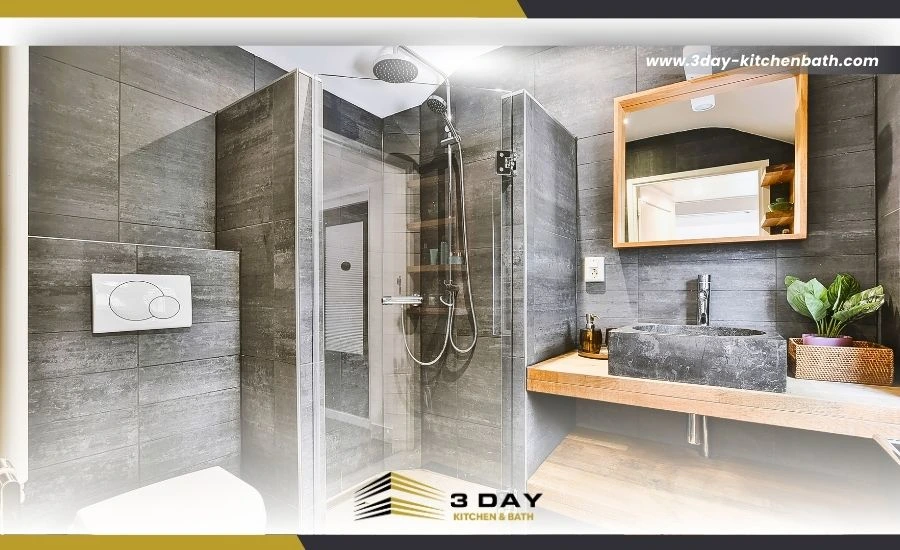
Making Smart Choices for Your Bathroom Remodel
Understanding the costs associated with bathroom remodels, particularly with plumbing, tile work, and vanities, helps you make smart, informed decisions. By focusing on these key areas, you can plan your project efficiently and avoid unexpected expenses. Whether you are remodeling a small bathroom or upgrading a master suite, having a clear budget breakdown will guide you throughout the process.
At 3 Day Kitchen & Bath, we work closely with you to ensure your remodel is both stylish and budget-friendly. Our experienced team in San Diego, CA, is ready to bring your vision to life while helping you manage costs effectively.
Frequently Asked Questions
How much does it cost to install a custom vanity?
The cost of installing a custom vanity depends on the materials, size, and design. On average, custom vanities can range from $1,900 to $4,800. This price includes the materials, labor, and any additional features you may want, such as high-end finishes or unique hardware. Custom vanities offer a personalized touch but come at a higher price than stock options.
What are the pros and cons of using stock vanities?
Stock vanities are affordable and readily available, making them a great choice for budget-conscious homeowners. They typically cost between $700 and $900, and installation is quicker than with custom vanities. However, the main drawback is that they come in standard sizes and designs, offering less flexibility in terms of style and storage options compared to custom choices.
Is it worth investing in high-end flooring for a small bathroom?
Investing in high-end flooring for a small bathroom can be worth it if you want long-lasting durability and an upscale look. High-end materials like natural stone or porcelain offer elegance and are more resistant to wear and moisture. However, for small spaces, more affordable options like ceramic or vinyl can still provide a stylish, durable finish without breaking the bank.
How can I reduce labor costs in a bathroom remodel?
To reduce labor costs, consider keeping the existing layout of your bathroom to avoid the extra expense of moving plumbing or electrical fixtures. Opt for simpler designs and materials that are easier to install, and get multiple quotes from contractors to ensure you're getting a fair price. Doing some minor tasks like painting or demolition yourself can also help save on labor.
Are there ways to upgrade plumbing without moving fixtures?
Yes, you can upgrade plumbing without moving fixtures by replacing old pipes, faucets, or showerheads. Installing water-efficient fixtures or upgrading to modern materials like PEX piping can improve performance without the high costs of relocating plumbing lines. This approach helps you save on labor costs while still modernizing your bathroom.
Plan Your Bathroom Remodel with 3 Day Kitchen & Bath
Ready to transform your bathroom? Call 3 Day Kitchen & Bath at (619) 604-9103 to start planning your remodel in San Diego, CA. Our expert team is here to help you create a stylish and functional bathroom within your budget.



